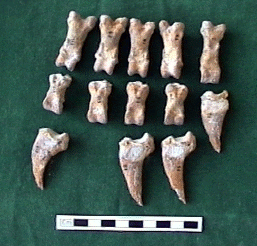Animal Bones
by Louise Martin and Nerissa RussellLarge quantities of animal bones and teeth were recovered during the 1998 field season, reflecting good preservation conditions for bone at the site. Sheep and goat bones predominate, while lower frequencies of cattle, wild horses and asses, red deer, wild boar, foxes, dogs and birds were found. The domestic/wild status of the cattle, sheep and goats at Çatalhöyük is still under investigation, but the wide range of animal sizes evident for each of these animals might suggest that both wild and domestic varieties were present.
In the Mellaart area, we continued to investigate patterns of animal bone discard. House floors and occupation layers appear to be relatively clean, although subtle variations between floor areas within the same house (e.g. space 150) may relate to use. Large-scale discard of food refuse occurs primarily in the midden areas (e.g. space 115), but also sometimes between house walls.

Figure 18: Bear Claw recovered during 1998 excavations |
Particularly noteworthy is a bear's claw (Figure 18) found in a small room in the Mellaart area. This is the first time bear bones have been identified from Çatalhöyük, and their rarity suggest that the bears were not common in the Konya Plain. More likely, they inhabited mountain areas, and the foot bones may have been imported to the site attached to a skin, or for some other purpose. |
Another interesting find this year was a cluster of 8 cattle scapulae (shoulder blades) which appear to have been deliberately placed together in House 3 in the BACH area. These are rather enigmatic, and it is not yet clear whether they represent tools such as shovels, or the remains of a feast, or joints of meat that were being preserved and stored.
Closer examination of the animal remains, including the large cattle bucranium just revealed in the BACH area, will shed light on many questions relating to the use and treatment of animals and their products.